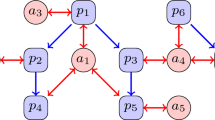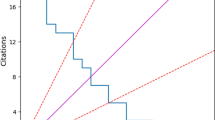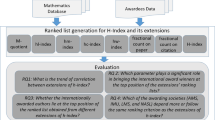Abstract
Ranking scientific authors is an important but challenging task, mostly due to the dynamic nature of the evolving scientific publications. The basic indicators of an author’s productivity and impact are still the number of publications and the citation count (leading to the popular metrics such as h-index, g-index etc.). H-index and its popular variants are mostly effective in ranking highly-cited authors, thus fail to resolve ties while ranking medium-cited and low-cited authors who are majority in number. Therefore, these metrics are inefficient to predict the ability of promising young researchers at the beginning of their career. In this paper, we propose \(C^3\)-index that combines the effect of citations and collaborations of an author in a systematic way using a weighted multi-layered network to rank authors. We conduct our experiments on a massive publication dataset of Computer Science and show that—(1) \(C^3\)-index is consistent over time, which is one of the fundamental characteristics of a ranking metric, (2) \(C^3\)-index is as efficient as h-index and its variants to rank highly-cited authors, (3) \(C^3\)-index can act as a conflict resolution metric to break ties in the ranking of medium-cited and low-cited authors, (4) \(C^3\)-index can also be used to predict future achievers at the early stage of their career.






Similar content being viewed by others
Notes
A supergraph of author-author coauthorship graph that takes into account social relationship between authors other than coauthorship: friends in the social media, Committee members of the same conference, editors of the same journal, members having same affiliation, etc. However, this feature is not frequently used due to the lack of suitable dataset.
References
Abramo, G., DAngelo, C. A., & Solazzi, M. (2011). Are researchers that collaborate more at the international level top performers? An investigation on the Italian university system. Journal of Informetrics, 5(1), 204–213. doi:10.1016/j.joi.2010.11.002.
Barabási, A. L., Jeong, H., Néda, Z., Ravasz, E., Schubert, A., & Vicsek, T. (2002). Evolution of the social network of scientific collaborations. Physica A: Statistical mechanics and its applications, 311(3), 590–614.
Boccaletti, S., Bianconi, G., Criado, R., del Genio, C., Gmez-Gardees, J., Romance, M., et al. (2014). The structure and dynamics of multilayer networks. Physics Reports, 544(1), 1–122. doi:10.1016/j.physrep.2014.07.001.
Bollen, J., Rodriquez, A. M., & Van de Sompel, H. (2006). Journal status. Scientometrics, 69(3), 669–687. doi:10.1007/s11192-006-0176-z.
Bornmann, L., & Daniel, H. D. (2009). The state of h index research. EMBO Reports, 10(1), 2–6.
Byrnes, J. P. (2007). Publishing trends of psychology faculty during their pretenure years. Psychological Science, 18(4), 283–286.
Cacioppo, J.T. (2008) Metrics of Science. Association for Psychological Science, 21(1). http://www.psychologicalscience.org/index.php/publications/observer/2008/january-08/metrics-of-science.html.
Cacioppo, J. T. (2016). Social neuroscience. Cambridge: MIT Press.
Carley, S., Porter, A. L., & Youtie, J. (2013). Toward a more precise definition of self-citation. Scientometrics, 94(2), 777–780. doi:10.1007/s11192-012-0745-2.
Chakraborty, T., Ganguly, N., & Mukherjee, A. (2014a). Automatic classification of scientific groups as productive: An approach based on motif analysis. In International Conference on Advances in Social Networks Analysis and Mining (ASONAM) (pp. 130–137). doi:10.1109/ASONAM.2014.6921572.
Chakraborty, T., Ganguly, N., & Mukherjee, A. (2015a). An author is known by the context she keeps: Significance of network motifs in scientific collaborations. Social Network Analysis and Mining, 5(1), 16:1–16:21. doi:10.1007/s13278-015-0255-3.
Chakraborty, T., Kumar, S., Goyal, P., Ganguly, N., & Mukherjee, A. (2015b). On the categorization of scientific citation profiles in computer science. Communications of the ACM, 58(9), 82–90. doi:10.1145/2701412.
Chakraborty, T., Sikdar, S., Ganguly, N., & Mukherjee, A. (2014b). Citation interactions among computer science fields: A quantitative route to the rise and fall of scientific research. Social Network Analysis and Mining, 4(1), 187. doi:10.1007/s13278-014-0187-3.
Chakraborty, T., Sikdar, S., Tammana, V., Ganguly, N., & Mukherjee, A. (2013) Computer science fields as ground-truth communities: Their impact, rise and fall. In ASONAM (pp. 426–433). Niagara Falls, Canada
Chen, P., Xie, H., Maslov, S., & Redner, S. (2007). Finding scientific gems with Google’s PageRank algorithm. Journal of Informetrics, 1(1), 8–15. doi:10.1016/j.joi.2006.06.001.
Costas, R., & Bordons, M. (2007). The h-index: Advantages, limitations and its relation with other bibliometric indicators at the micro level. Journal of Informetrics, 1(3), 193–203. doi:10.1016/j.joi.2007.02.001.
Cui, J., Wang, F., & Zhai, J. (2010). Citation Networks as a multi-layer graph: Link prediction and importance ranking. Stanford Student Project. http://snap.stanford.edu/class/cs224w-2010/proj2010/05_ProjectReport.pdf
De Domenico, M., Sole-Ribalta, A., Omodei, E., Gomez, S., Arenas, A. (2015). Ranking in interconnected multilayer networks reveals versatile nodes. Nature Communications, 6. doi:10.1038/ncomms7868
Deng, H., Han, J., Lyu, M.R., & King, I. (2012). Modeling and exploiting heterogeneous bibliographic networks for expertise ranking. In Proceedings of the 12th ACM/IEEE-CS Joint Conference on Digital Libraries, JCDL ’12 (pp. 71–80). ACM, New York. doi:10.1145/2232817.2232833.
Ding, Y. (2011). Applying weighted pagerank to author citation networks. Journal of the American Society for Information Science and Technology, 62(2), 236–245. doi:10.1002/asi.21452.
Ding, Y., & Cronin, B. (2011). Popular and/or prestigious? Measures of scholarly esteem. Information Processing and Management, 47(1), 80–96. doi:10.1016/j.ipm.2010.01.002.
Ding, Y., Yan, E., Frazho, A., & Caverlee, J. (2009). PageRank for ranking authors in co-citation networks. Journal of the American Society for Information Science and Technology, 60(11), 2229–2243. doi:10.1002/asi.21171.
Egghe, L. (2006). Theory and practise of the g-index. Scientometrics, 69(1), 131–152. doi:10.1007/s11192-006-0144-7.
Falagas, M. E., Kouranos, V. D., Arencibia-Jorge, R., & Karageorgopoulos, D. E. (2008). Comparison of SCImago journal rank indicator with journal impact factor. The FASEB Journal, 22(8), 2623–2628.
Fiala, D., Rousselot, F., & Ježek, K. (2008). PageRank for bibliographic networks. Scientometrics, 76(1), 135–158. doi:10.1007/s11192-007-1908-4.
Fiala, D., Subelj, L., Zitnik, S., & Bajec, M. (2015). Do PageRank-based author rankings outperform simple citation counts? Journal of Informetrics, 9(2), 334–348. doi:10.1016/j.joi.2015.02.008.
Halu, A., Mondragn, R. J., Panzarasa, P., & Bianconi, G. (2013). Multiplex PageRank. PLoS One, 8(10), 1–10. doi:10.1371/journal.pone.0078293. http://dx.doi.org/10.1371%2Fjournal.pone.0078293.
Hirsch, J.E. (2005). An index to quantify an individual’s scientific research output. In Proceedings of the National Academy of Sciences of the United States of America, 102(46), 16569–16572. doi:10.1073/pnas.0507655102. http://www.pnas.org/content/102/46/16569.abstract.
Hirsch, J. E. (2010). An index to quantify an individual’s scientific research output that takes into account the effect of multiple coauthorship. Scientometrics, 85(3), 741–754. doi:10.1007/s11192-010-0193-9.
Jin, B., Liang, L., Rousseau, R., & Egghe, L. (2007). The R- and AR-indices: Complementing the h-index. Chinese Science Bulletin, 52(6), 855–863. doi:10.1007/s11434-007-0145-9.
Kosmulski, M. (2006). A new Hirsch-type index saves time and works equally well as the original h-index. ISSI Newsletter (pp. 4–6).
Liu, J., Lei, K.H., Liu, J.Y., Wang, C., & Han, J. (2013). Ranking-based name matching for author disambiguation in bibliographic data. In Proceedings of the 2013 KDD Cup 2013 Workshop, KDD Cup ’13 (pp. 8:1–8:8). ACM, Chicago. doi:10.1145/2517288.2517296.
Liu, X., Bollen, J., Nelson, M. L., & Van de Sompel, H. (2005). Co-authorship networks in the digital library research community. Information Processing and Management, 41(6), 1462–1480. doi:10.1016/j.ipm.2005.03.012.
Long, J. S. (1992). Measures of sex differences in scientific productivity. Social Forces, 71(1), 159–178.
Ma, N., Guan, J., & Zhao, Y. (2008). Bringing PageRank to the citation analysis. Information Processing and Management, 44(2), 800–810. doi:10.1016/j.ipm.2007.06.006. Evaluating exploratory search systems digital libraries in the context of users broader activities.
Maslov, S., & Redner, S. (2008). Promise and pitfalls of extending Google’s PageRank algorithm to citation networks. The Journal of Neuroscience, 28(44), 11103–11105.
Melin, G. (2000). Pragmatism and self-organization: Research collaboration on the individual level. Research Policy, 29(1), 31–40.
Murthy, D., & Lewis, J. P. (2015). Social media, collaboration, and scientific organizations. American Behavioral Scientist, 59(1), 149–171. doi:10.1177/0002764214540504. http://abs.sagepub.com/content/59/1/149.abstract.
Nykl, M., Jeek, K., Fiala, D., & Dostal, M. (2014). PageRank variants in the evaluation of citation networks. Journal of Informetrics, 8(3), 683–692. doi:10.1016/j.joi.2014.06.005.
Ortega, J. L. (2014). Influence of co-authorship networks in the research impact: Ego network analyses from microsoft academic search. Journal of Informetrics, 8(3), 728–737. doi:10.1016/j.joi.2014.07.001.
Pinski, G., & Narin, F. (1976). Citation influence for journal aggregates of scientific publications: Theory, with application to the literature of physics. Information Processing and Management, 12(5), 297–312.
Pradhan, D., Chakraborty, T., Pandit, S., & Nandi, S. (2016). On the discovery of success trajectories of authors. In Proceedings of the 25th International Conference on World Wide Web (WWW) (pp. 91–92). doi:10.1145/2872518.2889375.
Pradhan, D., Paul, P.S., Maheswari, U., Nandi, S., & Chakraborty, T. (2016). \(\text{C}^{3}\)-index: Revisiting author’s performance measure. In Proceedings of the 8th ACM Conference on Web Science, WebSci 2016. Hannover, Germany, May 22–25, 2016 (pp. 318–319).
Radicchi, F., Fortunato, S., Markines, B., & Vespignani, A. (2009). Diffusion of scientific credits and the ranking of scientists. Physical Review E, 80(5), 056–103.
Redner, S. (2010). On the meaning of the h-index. Journal of Statistical Mechanics: Theory and Experiment, 2010(03), L03,005.
Senanayake, U., Piraveenan, M., & Zomaya, A. (2014). Ranking scientists from the field of quantum game theory using p-index. In Foundations of Computational Intelligence (FOCI), 2014 IEEE Symposium on (pp. 9–16). doi:10.1109/FOCI.2014.7007801
Senanayake, U., Piraveenan, M., & Zomaya, A. (2014). The p-index: Ranking scientists using network dynamics. Procedia Computer Science, 29, 465–477. doi:10.1016/j.procs.2014.05.042.
Senanayake, U., Piraveenan, M., & Zomaya, A. (2015). The PageRank-index: Going beyond citation counts in quantifying scientific impact of researchers. PLoS One, 10(8), 1–34. doi:10.1371/journal.pone.0134794. http://dx.doi.org/10.1371%2Fjournal.pone.0134794.
Tahamtan, I., Safipour Afshar, A., & Ahamdzadeh, K. (2016). Factors affecting number of citations: A comprehensive review of the literature. Scientometrics, 107(3), 1195–1225. doi:10.1007/s11192-016-1889-2.
Trueba, F. J., & Guerrero, H. (2004). A robust formula to credit authors for their publications. Scientometrics, 60(2), 181–204. doi:10.1023/B:SCIE.0000027792.09362.3f.
Tscharntke, T., Hochberg, M. E., Rand, T. A., Resh, V. H., & Krauss, J. (2007). Author sequence and credit for contributions in multiauthored publications. PLOS Biology, 5(1), 1–2. doi:10.1371/journal.pbio.0050018. http://www.ncbi.nlm.nih.gov/pmc/articles/PMC1769438/.
Waltman, L., Costas, R., & van Eck, N. J. (2012). Some limitations of the H index: A commentary on Ruscio and colleagues’ analysis of bibliometric indices. Measurement: Interdisciplinary Research and Perspectives, 10(3), 172–175. doi:10.1080/15366367.2012.716260.
Waltman, L., & van Eck, N. J. (2012). The Inconsistency of the H-index. Journal of the American Society for Information Science and Technology, 63(2), 406–415. doi:10.1002/asi.21678.
Xu, J., Ding, Y., Song, M., & Chambers, T. (2016). Author credit-assignment schemas: A comparison and analysis. Journal of the Association for Information Science and Technology, 67(8), 1973–1989. doi:10.1002/asi.23495.
Yan, E., & Ding, Y. (2009). Applying centrality measures to impact analysis: A coauthorship network analysis. Journal of the American Society for Information Science and Technology, 60(10), 2107–2118. doi:10.1002/asi.21128.
Yan, E., Ding, Y., & Sugimoto, C. R. (2011). P-Rank: An indicator measuring prestige in heterogeneous scholarly networks. Journal of the American Society for Information Science and Technology, 62(3), 467–477. doi:10.1002/asi.21461.
Zhou, D., Orshanskiy, S.A., Zha, H., & Giles, C.L. (2007). Co-ranking authors and documents in a heterogeneous network. In Seventh IEEE International Conference on Data Mining (ICDM 2007). IEEE, Omaha, Nebraska (pp. 739–744).
Życzkowski, K. (2010). Citation graph, weighted impact factors and performance indices. Scientometrics, 85(1), 301–315.
Author information
Authors and Affiliations
Corresponding author
Rights and permissions
About this article
Cite this article
Pradhan, D., Paul, P.S., Maheswari, U. et al. \(C^3\)-index: a PageRank based multi-faceted metric for authors’ performance measurement. Scientometrics 110, 253–273 (2017). https://doi.org/10.1007/s11192-016-2168-y
Received:
Published:
Issue Date:
DOI: https://doi.org/10.1007/s11192-016-2168-y




